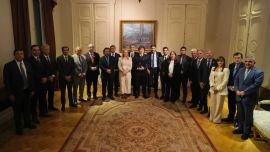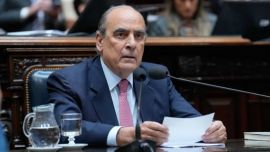The opinion, presented to Judge Julián Ercolini, reignites the controversial case that has shaken the country’s politics since Nisman was found dead in his apartment on January 18 2015, with a gunshot wound to the head. It is a reversal of the previous main hypothesis, which leant toward suicide or induced suicide.
In a 1,087-page report, Taiano said tests were “conclusive” and had proved “unfailingly” that the late prosecutor was murdered. He asked the judge to classify the case as a “homicide” investigation, altering the previous designation of “suspicious death.” “The circumstances surrounding the death of the victim,prevent the possibility of suicide being even considered,” Taiano wrote.
Reaction to the move was swift, with Ercolini ordering within hours that computer specialist Diego Lagomarsino must give evidence on Tuesday (November 14) and that he be fitted with an electronic GPS bracelet. Lagomarsino’s home in Martínez was also raided as part of a search for new evidence.
In previous testimony, Lagomarsino admitted loaning Nisman the gun that was used to kill him, saying Nisman told him he feared for his life and his family’s safety.
Prosecutor Taiano also pointed the finger at Nisman’s security team. Four guards from the 10-strong team have been charged with failing to “ensure the safety” of the late AMIA special prosecutor.
Taiano’s written opinion said he suspects that Lagomarsino left the gun in Nisman’s apartment so that the actual killer or killers could use it and make the murder appear to be a suicide, pointing to the “relationship of trust” the specialist had with Nisman.
“I’ve asked that Lagomarsino be investigated as the primary participant in Nisman’s homicide, because he supplied the weapon,” Taiano told the EFE news agency.
Lagomarsino’s attorney did not requests for comment, but he spoke with La Nación on Wednesday from home, saying he “wanted to testify” and would “answer everything that is asked.”
A new report commissioned by Taiano, headed by the Gendarmerie (Border Guard), recently concluded that Nisman had killed by two people who drugged him and shot him after posing him against a bathtub.
Nisman’s death came four days after he formally accused then-president Cristina Fernández de Kirchner of covering up the role of Iranian officials in the 1994 bombing that killed 85 people and injured more than 300 at the AMIA Jewish community centre, and one day before he was due to explain his findings to Congress.
Fernández de Kirchner has always insisted she had nothing to with a cover-up or with Nisman’s death.
Initial police investigations, reports and autopsies concluded there was no sign anyone else had been present when Nisman died, though they left open the possibility of suicide, induced suicide or murder. The national forensics team said there was no concrete evidence it was a homicide and federal police said the prosecutor shot himself. But those reports were widely questioned and police and investigators were criticised for allowing numerous people into the apartment, contaminating the scene.
Speaking in New York this week, during an interview at the Council of the Americas prior to the new developments, President Mauricio Macri said publicly that “Nisman was killed and [that] we need to know who did it.”
Timeline of key events in the case
— Jan. 14, 2015: Alberto Nisman accuses then-president Cristina Fernández de Kirchner of covering up the role of former Iranian officials charged for the 1994 bombing of the AMIA Jewish community centre in which 85 people died.
— Jan. 15, 2015: A congressional commission asks Nisman to present evidence of his accusations that CFK, then-foreign minister Hector Timerman and other senior officials brokered a cover-up in exchange for favourable deals on oil and other goods from Iran.
— Jan. 18, 2015: Nisman is found dead in his apartment with a bullet in his right temple. A .22-calibre pistol is found next to him.
— Jan. 19, 2015: Prosecutor Viviana Fein tells reporters that the preliminary autopsy found “no intervention” of others in Nisman’s death, but stops short of calling it a suicide.
CFK publishes a letter, lamenting Nisman’s death and asking what “could have led him to take the terrible decision to take his own life.”
— Jan. 22, 2015: CFK publishes a second letter saying that she’s now convinced Nisman didn’t commit suicide. She suggests a recently deposed senior intelligence agent, Antonio Stiuso, was involved but does not elaborate.
— Jan. 29, 2015: Nisman aide Diego Lagomarsino, a computer technician, says the prosecutor asked to borrow a gun because he feared for his and his daughters’ lives.
— Feb. 3, 2015: Investigators say they found a draft document Nisman wrote requesting the arrest of CFK. The document is dated in 2014.
— Feb. 10, 2015: A probe finds no traces of gunpowder on Nisman’s hands, but experts say that doesn’t rule out the possibility he fired the gun.
— Feb. 12, 2015: Nisman’s ex-wife Sandra Arroyo Salgado, herself a federal judge, asks Congress to take the case to the Inter-American Commission on Human Rights.
— Feb. 26, 2015: Federal Judge Daniel Rafecas dismisses Nisman’s allegations against Fernandez, saying the evidence fails to meet “the minimal conditions needed to launch a formal court investigation.” An appeals court later upholds the dismissal.
— April 16, 2015: CFK’s Cabinet chief Aníbal Fernández accuses Nisman of having used state money for a kickback scheme and to entertain women.
— Sept 7, 2015: The lead investigator in Nisman’s death is sharply criticised after a video that shows police apparently failing to follow crime scene protocol in the apartment where Nisman was shot. Fein insists the crime scene had not been contaminated.
— Jan. 15, 2016: President Mauricio Macri orders the declassification of files related to Nisman’s death.
— March 19, 2016: Fein says for the first time that Nisman’s death might have been an induced suicide.
— Sept. 21, 2016: Argentina’s Supreme Court orders federal prosecutor Eduardo Taiano to take over the stalled case.
— Sept. 22, 2017: An investigation by the Gendarmerie (Border Guards) concludes that Nisman was murdered, contradicting earlier official.
— Nov. 8, 2017: Taiano asks a judge to rule that Nisman was murdered rather than possibly committing suicide, and to order testimony by Lagomarsino.
























Comments